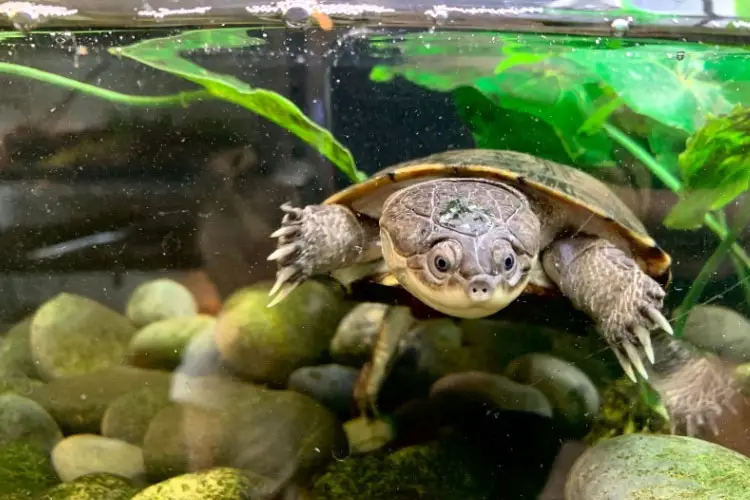How Long Can African Sideneck Turtles Be Out Of Water?
If you own the African Sideneck turtle or plan to get one, one of the things you need to know is how long it can stay out of the water without developing any problems. We have researched this topic and found interesting details that we’ll share with you shortly.
So, how long can African Sideneck turtles be out of water? African Sideneck turtles can be out of water for up to two weeks. This gives them an edge over most other turtle species.
The guide below sheds more light on how long you should put your African Sideneck out of the water, what happens when you keep it out of water for long, and other interesting info you need to know about housing them correctly.
How long can African Sideneck turtles stay out of water?
Contents
The African Sideneck turtles, also known as helmeted turtles or b their scientific name Pelomedusidae, can stay out of water for two weeks at a time.
Why are then Sideneck turtles capable of surviving outside water for this long?
The reason is pretty simple; these turtles are native to the West-African countries, including Angola, Congo, Sierra Leone, Guinea, Ghana, and Senegal.
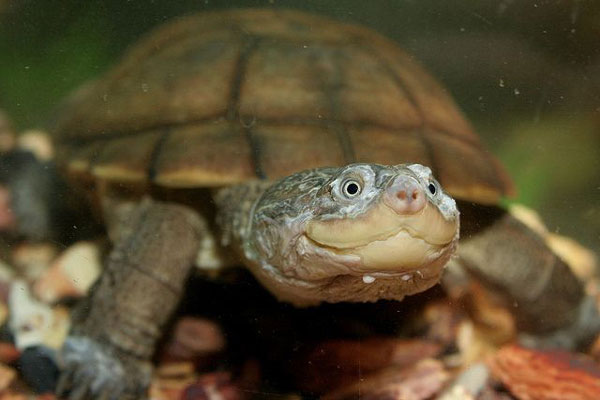
This means they live in a Sub-Saharan Africa climate that receives little to no rainfall. The rivers and other water bodies in these areas can go dry for as long as weeks or even a month at a time. This has forced the turtles to adapt to going for long without water, placing them a step above other aquatic and semi-aquatic turtle species.
That being, the exact length of time the Sideneck turtle can go without water depends on several factors discussed below:
- Turtle health: A well hydrated, well-fed, and healthy turtle can survive outside water for a longer period of time than an unhealthy turtle.
- Age: While adult Sideneck turtles like basking all the time, baby turtles like spending more time in the water. They are highly active at this stage of their lives and need to keep their bodies hydrated for rapid growth.
- Climate: African Sideneck turtles that live in high humid climates are capable of staying outside water without frequent hydration. This is because they can still get hydrated through moisture in the air in this type of climate, via their butt-breathing technique.
- Season: During winter, the turtle will enter into brumation mode and bury itself below the water bed or outside the water. This period can last for 2-5 months. Also, the turtle will aestivate during summer when the temperature is too high. It will do this by burying itself into the sand to help regulate its body temperature and can stay burrowed for a few months.
How long can baby African Sideneck turtles be out of water?
Baby African Sideneck turtles can survive for up to 1 day out of water. Unlike the adult turtles, these young turtles are unable to survive for long out of water.
They require food and water to help them sustain speedy growth, making them unable to go for more than a day without water.
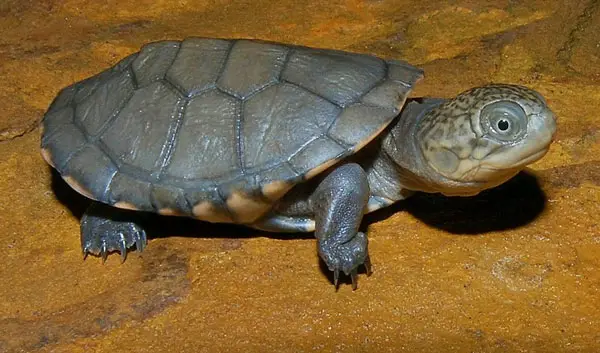
If you have a baby Sideneck turtle, we caution you against taking them through long periods of dryness.
If you do, they’ll most likely develop complications such as ingestion and malnutrition, which can lead to death.
What happens to the African Sideneck turtle body if it stays out of water?
When kept outside water for long, the body of an African Sideneck turtle will become dehydrated. The heat outside will deplete the water content inside their bodies and leave them dehydrated.
Without water, your pet turtle may turn lethargic and its body health will most likely deteriorate. They will also be unable to ingest food due to a lack of water in their digestive tract.
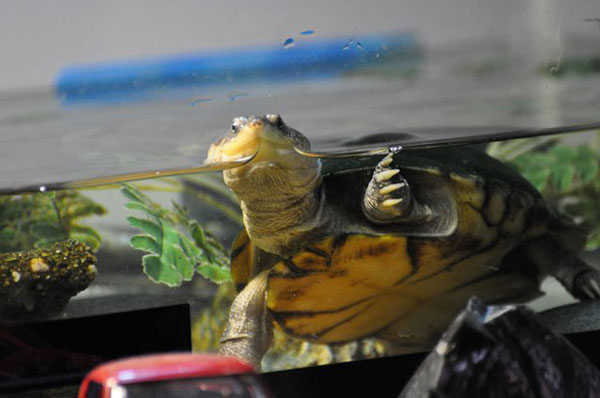
If not treated on time, dehydration in turtles can lead to long-term health issues like bladder stones, shell deformation, respiratory infections, and even death!
And this brings us to our next topic below, on how you can tell if your turtle is dehydrated…
How can you tell if an African Sideneck turtle is dehydrated?
You can tell if your African Sideneck turtle is dehydrated by looking out for key signs like sunken or closed eyes, weight loss, wrinkled skin, and lethargy.
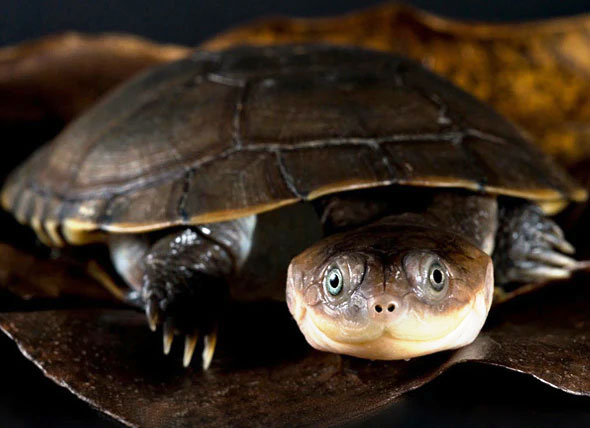
Let’s briefly discuss each of these signs below:
- Weight loss: Since a significant part of the turtle’s body weight is comprised of water, dehydration will leave them with drastic weight loss.
- Wrinkled skin: Try gently pinching the skin of your pet turtle. If it doesn’t slide back to its natural position, then it’s wrinkled, and your turtle could be dehydrated. Flaky skin also means your pet turtle is dehydrated.
- Closed/sunken eyes: If your turtle shows closed or sunken eyes (or hollowness near its eyelids), that’s another sign of dehydration!
- Lethargy: Dehydrated turtles prefer staying in one place and show no interest in foraging or swimming.
How much water do African Sideneck turtles need?
The amount of water African Sideneck turtles need depends on their size; we recommend 10 gallons of water for every inch of their shell length.
This applies to pretty much all the other species of turtles, including the African mud turtle that’s close to the Sideneck turtle.
For instance, if your Sideneck turtle has a shell length of 10 inches, put them in a tank that contains at least 100 gallons of water.

Housing your turtle in an enclosure? It is not an uncommon practice for people to do. But if you go this path, make sure you provide your pet with a big enough tube to help them comfortably swim around. Also, ensure the turtle has easy access to the water.
On top of it all, make sure your turtle easily gets out of the water. Although a Sideneck is an aquatic turtle, it can easily drown if not given an easy way out of the water.
When can an African Sideneck turtle go for months without water?
The only time an African Sideneck turtle can survive for months outside water is when it is brumating or aestivating.
During these phases, the animal lowers its metabolism and cools down its body to help it use the minimal possible amounts of energy. This will enable the turtle to go for as many as 8 months out of water.
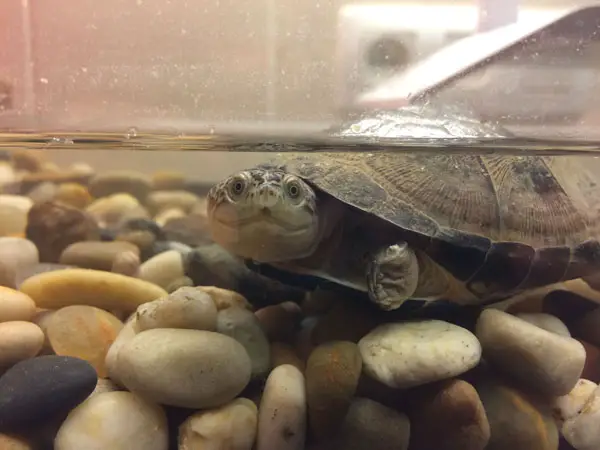
Why does my African Sideneck turtle keep trying to get out of the water?
Your African Sideneck turtle may keep trying to get out of the water if the water parameters or the temperature is unsuitable.
When the tank water temperatures are too hot or too cold, your turtle will feel uncomfortable and do everything to try and get out of the tank. Make sure your heat lamp maintains temperatures between 75 and 85 degrees F.
When a turtle is pregnant, it’d also try to escape the tank to go lay eggs in a dry spot. Looking for additional signs of a pregnant turtle to help you arrive at a more conclusive decision.
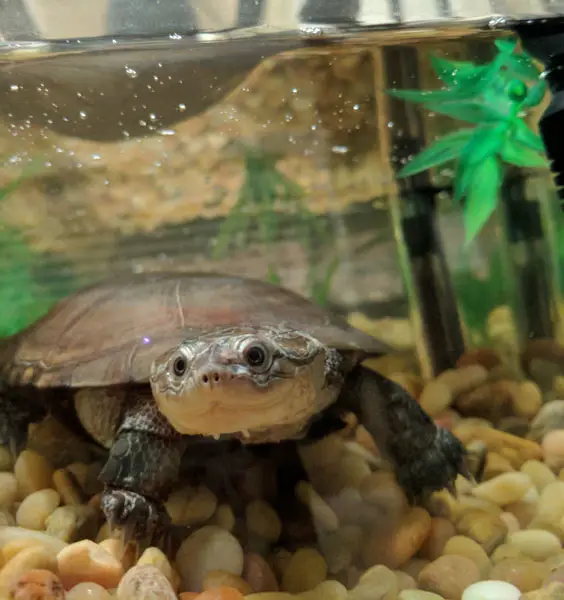
If you just introduced your Sideneck turtle to a new tank, it may feel stressed and anxious, and try to get out of the tank.
Food scarcity in the tank may also be the reason behind the turtle wanting to get out.
Your African Sideneck turtle could also have discovered an exit spot in the tank, giving them an idea to deliberately free. Not to forget, turtles are curious animals and like venturing outside.
FAQs:
Yes, African Sideneck turtles need water to survive. Despite their ability to live outside water for weeks, they’re still aquatic creatures and their natural habitat remains in the water. You must give your African Sideneck turtle access to water at all times.
The ideal water depth for an African Sideneck turtle is 6 to 8 inches. The turtle experts recommend keeping the level at least 1.5 times the length of your turtle. The ideal water levels will give them an ideal condition for comfortably floating, diving, and basking.
Absolutely! African Sideneck turtles are aquatic turtles, meaning water is their natural habitat, and must possess swimming skills to help them evade predators from land predators and catch their food in the water.
The following video will give you more information about the history, facts, and care for the African Sideneck turtle.
Final Verdict
That’s it about the African Sideneck turtle and its ability to stay out of water. This species of turtle is capable of staying for 1-2 weeks outside water without developing any health complications. And when in aestivation or brumation mode, they can last for months out of the water.
However, the natural habitat for these turtles remains in the water and you should never leave them outside water for long periods of time. You should also keep them well hydrated to prevent serious health problems or even death.


